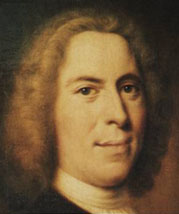Nicolaus Ludwig Zinzendorf | |
|---|---|
 Portrait of Zinzendorf by Balthasar Denner | |
| Full name | Nikolaus Ludwig, Reichsgraf von Zinzendorf und Pottendorf |
| Born | 26 May 1700 Dresden, Electorate of Saxony, Holy Roman Empire |
| Died | 9 May 1760 (aged 59) Herrnhut, Electorate of Saxony, Holy Roman Empire |
| Spouse(s) | Erdmuthe Dorothea of Reuss-Ebersdorf Anna Nitschmann |
| Signature |  |
| Occupation | Bishop of the Moravian Church |
Nikolaus Ludwig, Reichsgraf von Zinzendorf und Pottendorf (26 May 1700 – 9 May 1760) was a German religious and social reformer, bishop of the Moravian Church, founder of the Herrnhuter Brüdergemeine, Christian mission pioneer and a major figure of 18th-century Protestantism.
Born in Dresden, Zinzendorf was often influenced by strong and vehement feelings, and he was easily moved both by sorrow and joy. Called Ludwig or Brother Ludwig by his intimates, he was a natural orator, and though his dress was simple his personal appearance gave an impression of distinction and force. He was notable for providing shelter for German-speaking Moravian exiles at Herrnhut, an effort that was influenced by Pietist ideas from the Lutheran faith he was brought up in.
Zinzendorf was critical of slavery, and played a role in starting the Protestant mission movement by supporting two determined Moravian missionaries Johann Leonhard Dober and David Nitschmann to go (via Copenhagen) to the Danish colony of Saint Thomas to minister to the enslaved population there (see Moravian slaves). In spite of having Danish royal support from Charlotte Amalie of Denmark, these missionaries faced discouragement in several forms, including by some Moravians at Herrnhut (including Christian David), by the Danish West India Company, by planters in Saint Thomas, by the risk of getting malaria, and by the slaves themselves.
His projects were often misunderstood. In 1736 he was banished from Saxony, but in 1749 the government rescinded its decree and begged him to establish within its jurisdiction more settlements like that at Herrnhut.
Zinzendorf's effect on the Moravian Church was significant, and is still evident nearly three centuries later. He is commemorated as a hymnwriter and a renewer of the church by the Evangelical Lutheran Church in America on its Calendar of Saints on 9 May.